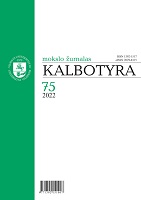Looking for the Articloid: Ille and ipse in the Itinerarium Egeriae
Looking for the Articloid: Ille and ipse in the Itinerarium Egeriae
Author(s): Antanas KeturakisSubject(s): Semantics, Historical Linguistics, Comparative Linguistics, Baltic Languages
Published by: Vilniaus Universiteto Leidykla
Keywords: Late Latin; definiteness; grammaticalization; definite article; articloid;
Summary/Abstract: This paper examines the status of the Latin demonstrative ille and the intensifier ipse, which are the sources of definite articles in modern Romance languages. My analysis is based on the text of the Itinerarium Egeriae from the end of the fourth century AD. Using the approach of cognitive linguistics, I suggest how the articloid could be defined and how it could be distinguished semantically from its source element. I argue that both ille and ipse are used as articloids in the text. However, the original demonstrative meaning of ille and the original intensifying meaning of ipse are also attested, and in certain cases; though redundant, their use can be caused by the specific stylistics of the text. Furthermore, ipse has developed an additional meaning that establishes identity through similarity, and which might have led the path to its further grammaticalization. Therefore, both ille and ipse have a spectrum of interrelated meanings that range from those attested in Classical Latin to grammatical usage as articloids. However, as definiteness markers, their usage is not extended into contexts reserved for definite articles in languages with fully grammaticalized definiteness markers and hence its use as an articloid in the Latin of the fourth century AD could have been typologically equivalent to that of the articloid in the Baltic languages.
Journal: Kalbotyra
- Issue Year: 2022
- Issue No: 75
- Page Range: 57-81
- Page Count: 25
- Language: English

